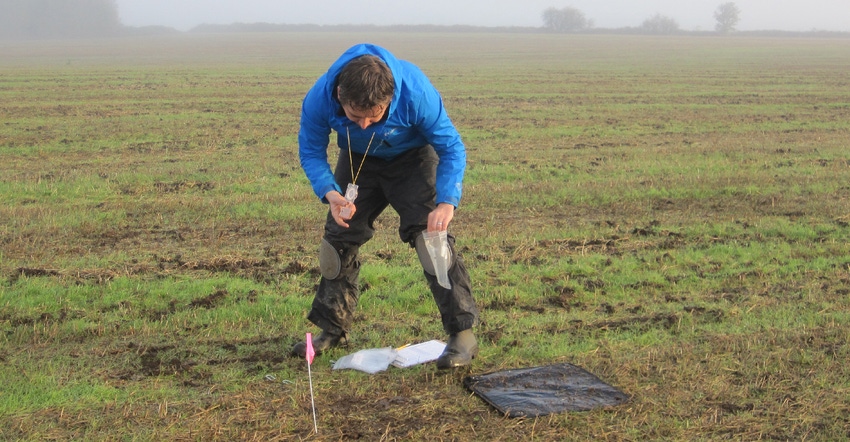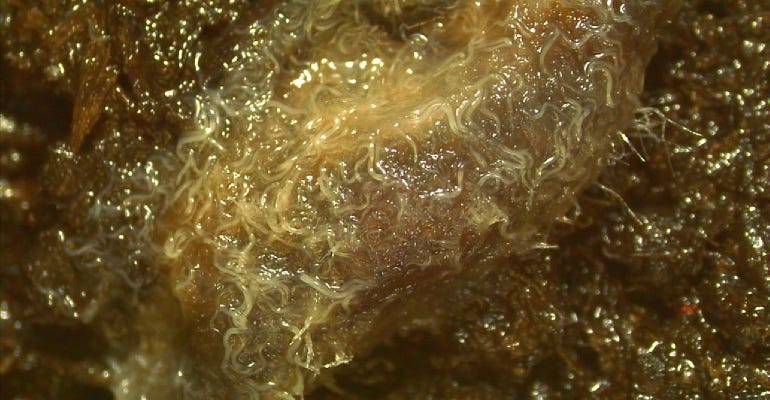November 27, 2020

In agriculture, nematodes are not an unknown animal. Often, they’re invasive and can cause crop damage, for example in corn, or Midwest soybeans. But these tiny wormlike bugs can also be beneficial, and a recent discovery at Oregon State University could help battle a significant crop pest — slugs.
In Oregon, at last half of the 20 top agricultural commodities suffer from slug damage. This group includes the grass seed industry, which sees about $60 million in losses annually, according to Rory McDonnell, associate professor in crop and soil science in the OSU College of Agricultural Sciences and slug specialist for OSU Extension. McDonnell adds that figures aren’t available for the $1 billion nursery industry, but slugs and snails account for major losses in that sector, too.
The parasitic nematode, Phasmarhabditis hermaphrodita, found on the Corvallis, Ore., campus, could decrease those losses significantly, according to nematode specialist Dee Denver, who is also professor and head of the OSU Department of Integrated Biology in the College of Science. This nematode has been used in Europe as a biocontrol under the brand name Nemaslug for more than 25 years but is not registered in the United States by the U.S. EPA.
As McDonnell notes, “The thought process is that if it works in Europe, and we find it here and it works here, it might be easier to get it registered by the EPA. If we can provide evidence it’s native, that makes a strong case for developing it as a biocontrol. But we want to make sure there are not effects on native slugs or snails. We don't want biocontrol gone awry. That’s very, very important.”
Taking on slugs
For now, growers rely on chemicals to control slugs and see 10% to 60% efficacy, McDonnell says. Those pesticides can have unintended effects on nontarget organisms and can contaminate waterways. “The damage they cause is a massive issue,” McDonnell says. “We surveyed 200 growers throughout the Willamette Valley to gather their opinion of controlling slugs with pesticide. We found only 30% said they were happy with the performance of chemicals.”
 PRETTY GRUESOME: Beneficial bugs can do serious damage to target hosts. In this case, a gray slug is overrun with nematodes. The nematodes can reproduce inside the slug very rapidly and in great numbers.
PRETTY GRUESOME: Beneficial bugs can do serious damage to target hosts. In this case, a gray slug is overrun with nematodes. The nematodes can reproduce inside the slug very rapidly and in great numbers.

For three years, McDonnell — whose position was originally funded by the Oregon Legislature to find solutions to the state’s slug problem — traveled Oregon hoping to find P. hermaphrodita. When he did, it was in his backyard, on the OSU campus in Corvallis. The discovery was the first in North America outside of California, where researchers at the University of California, Riverside, including McDonnell, found it in 2014.
Finding the nematode wasn’t easy. There are thousands, if not millions, of nematode species, and comma-sized P. hermaphrodita is almost invisible to the untrained eye. To identify it, Denver, who is a nematode specialist, had to extract and sequence its DNA and compare it to a national repository.
To locate the nematode, McDonnell and his staff set and scouted traps at the edges of agricultural fields, looking for gray field slugs (Deroceras reticulatum) that may have succumbed to nematodes. The nematodes invade the slug through a hole at the back of its mantle — the saddle-shaped part at the front of the slug. Once inside, the nematode kills and feeds on the slug and reproduces at a fast rate; one nematode can produce thousands of offspring in a matter of one to two weeks.
Denver shares the true impact: “When a slug is infested with nematodes, it liquifies. You end up with a swarming pile of worms. It's pretty gruesome.”
The gray field slug, which is the bane of home gardeners as well as agriculture, has invaded most of the world. It is the most important invasive slug species in agricultural production, McDonnell says. In Europe, P. hermaphrodita can reduce crop damage by slugs by up to 90%. Direct damage isn’t the only way D. reticulatum affects plants; it can be a vector for disease, and it also defecates and leaves slime trails, which reduces the quality of the crop.
As they continue to work on P. hermaphrodita, Denver and McDonnell are growing other species to determine genetic relationships and perhaps discover related nematodes that also have potential as biocontrols.
Source: Oregon State University, which is solely responsible for the information provided and is wholly owned by the source. Informa Business Media and all its subsidiaries are not responsible for any of the content contained in this information asset.
You May Also Like




